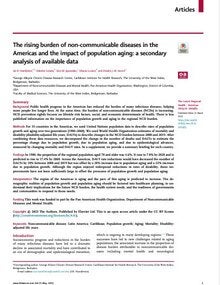Summary
Background
Public health progress in the Americas has reduced the burden of many infectious diseases, helping more people live longer lives. At the same time, the burden of non-communicable diseases (NCDs) is increasing. NCD prevention rightly focuses on lifestyle risk factors, social, and economic determinants of health. There is less published information on the importance of population growth and aging to the regional NCD burden.
Methods
For 33 countries in the Americas, we used United Nations population data to describe rates of population growth and aging over two generations (1980–2060). We used World Health Organization estimates of mortality and disability (disability-adjusted life years, DALYs) to describe changes in the NCD burden between 2000 and 2019. After combining these data resources, we decomposed the change in the number of deaths and DALYs to estimate the percentage change due to population growth, due to population aging, and due to epidemiological advances, measured by changing mortality and DALY rates. In a supplement, we provide a summary briefing for each country.
Findings
In 1980, the proportion of the regional population aged 70 and older was 4.6%. It rose to 7.8% by 2020 and is predicted to rise to 17.4% by 2060. Across the Americas, DALY rate reductions would have decreased the number of DALYs by 18% between 2000 and 2019 but was offset by a 28% increase due to population aging and a 22% increase due to population growth. Although the region enjoyed widespread reductions in rates of disability, these improvements have not been sufficiently large to offset the pressures of population growth and population aging.
Interpretation
The region of the Americas is aging and the pace of this aging is predicted to increase. The demographic realities of population growth and population aging should be factored into healthcare planning, to understand their implications for the future NCD burden, the health system needs, and the readiness of governments and communities to respond to those needs.
Funding
This work was funded in part by the Pan American Health Organization, Department of Noncommunicable Diseases and Mental Health.
|

